
 Document
Document
Virtual Case Study - Matthew Goldblatt, M.D., FACS: Visible tissue responsiveness: Metabolic and fibroblast activity during utilization of a bioabsorbable matrix in abdominal wall reconstruction
Visible tissue responsiveness: Metabolic and fibroblast activity during utilization of a bioabsorbable matrix in abdominal wall reconstruction Document
Document
Better AWR Outcomes. Reinforced by Data. Critical healing period and repair strength
GORE® BIO-A® Tissue Reinforcement provides a unique 3D tissue-building scaffold that elicits a specific tissue response during the critical wound healing period. Video
Video
Trends, Tools, Trials: Complex Abdominal Wall Repair in 2020
Matthew I. Goldblatt, M.D., FACS, discusses a case study of a patient undergoing treatment for simultaneous colon and rectal cancers and had a prior low anterior colon resection procedure with a diverting ileostomy. Document
Document
Bioabsorbable Mesh for Hernia Repair: Know your Options
GORE® BIO-A® Tissue Reinforcement is intended for use in the reinforcement of soft tissue. GORE® BIO-A® Tissue Reinforcement may be used include hernia repair as suture-line reinforcement, muscle flap reinforcement, and general tissue reconstructions.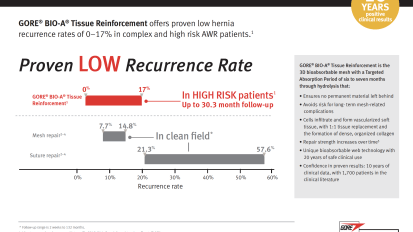 Document
Document
Better AWR Outcomes. Reinforced by Data. GORE® BIO-A® Tissue Reinforcement offers low complication rates in complex and high-risk patients
GORE® BIO-A® Tissue Reinforcement offers proven low hernia recurrence rates of 0–17% in complex and high risk AWR patients. Document
Document
Better AWR Outcomes. Reinforced by Data. Confidence for surgeons and patients in ventral hernia repair
GORE® BIO-A® Tissue Reinforcement is designed as an alternative to longer-term resorbable and permanent meshes to offer a strong repair while avoiding risk for long-term mesh-related complications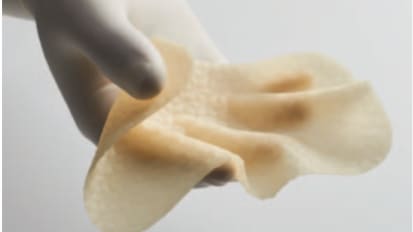 Document
Document
Advances in Bioabsorbable Implants for Abdominal Wall Reconstruction: Utility of GORE® ENFORM Biomaterial
GORE® ENFORM Biomaterial is a reinforcement for soft tissue composed of synthetic bioabsorbable polyglycolic acid and trimethylene carbonate which has proven to be effective for hernia repair.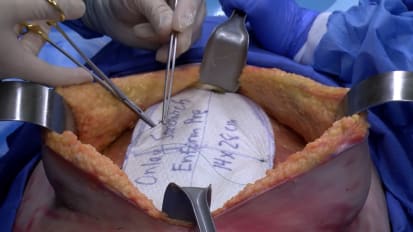 Video
Video
Retromuscular Onlay Hernia Repair Using GORE® ENFORM Preperitoneal Biomaterial
This is an educational surgical technique video demonstrating a retromuscular onlay hernia repair using GORE® ENFORM Preperitoneal Biomaterial. A cadaver model is used for demonstration to facilitate visualization of the anatomy. This educational content provided by John P. Fischer, M.D. Document
Document
General Surgery News Special Report: Clinical Discussion of Advances in Tissue Reinforcement for Abdominal Wall Reconstruction
In early 2021, as part of the Gore Medical Mastery Series, a faculty of surgeons convened in a virtual hybrid symposium in the midst of the COVID-19 pandemic to discuss their approaches to AWR, hernia repair, and tissue reinforcement. Document
Document
Retro-rectus Placement of Bio-absorbable Mesh Improves Patient Outcomes
Our primary objective was to determine the longterm surgical outcomes of retro-rectus and intraperiteonal placement of mesh.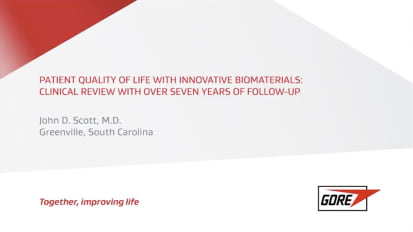 Video
Video
Patient quality of life with innovative biomaterials: Clinical review with over seven years of follow up
John Scott, MD, FACS, provides a post-operative clinical review of patients' quality of life after a hernia repair.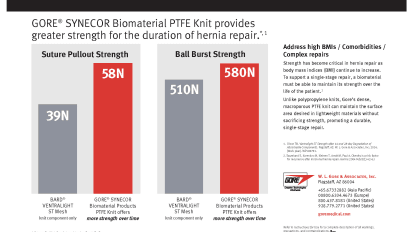 Document
Document
28-Day Strength Charts: GORE® SYNECOR Intraperitoneal Biomaterial
GORE® SYNECOR Biomaterial PTFE Knit provides greater strength for the duration of hernia repair.